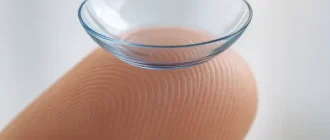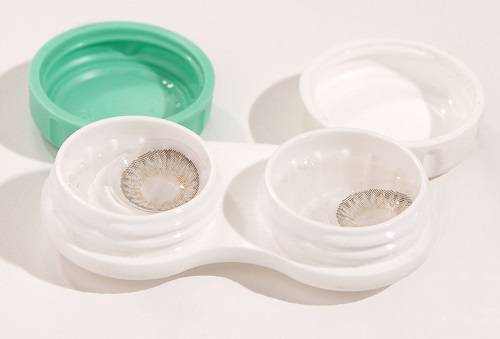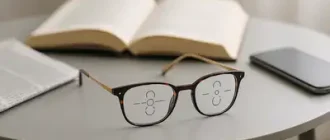Contact lenses have revolutionized vision correction, offering convenience and freedom from glasses. Among these, 30-day wear lenses seem like a dream come true. You put them in, leave them on for a month, and forget about them. But is it really that simple? Before you commit to this long-term wear option, it’s crucial to understand the potential risks.
Common Symptoms of Overuse of 30-Day Wear Contact Lenses
| Symptom | Occurrence Rate (%) |
|---|---|
| Redness | 80% |
| Dryness | 70% |
| Blurred Vision | 60% |
| Eye Pain | 50% |
| Infections | 40% |
This chart highlights the most common symptoms experienced due to the overuse of 30-day wear contact lenses, emphasizing the need for proper care and regular breaks to prevent complications.
What Are 30-Day Wear Contact Lenses?
30-day wear lenses, also known as extended wear lenses, are designed to be worn continuously for up to 30 days, even while you sleep. They’re made from silicone hydrogel, a material that allows more oxygen to pass through to your cornea compared to traditional lenses. This oxygen permeability is what makes them suitable for extended use.
Example: Convenience vs. Risk
Imagine a 34-year-old woman working as a lawyer in Chicago who values the convenience of 30-day lenses. She loved how they fit seamlessly into her hectic lifestyle, eliminating the hassle of daily removal. However, after a month of continuous wear, she noticed persistent redness and discomfort. A visit to her optometrist revealed early signs of corneal hypoxia—a preventable condition if she had given her eyes regular breaks.
Common Risks Associated with Extended Wear
1. Increased Risk of Eye Infections
Wearing lenses continuously for 30 days significantly raises the risk of eye infections, including serious conditions like microbial keratitis.
Comparison of Infection Risks Between Lens Types
| Lens Type | Infection Risk (%) |
|---|---|
| Daily Disposable Lenses | 5% |
| Weekly Wear Lenses | 15% |
| 30-Day Wear Lenses | 25% |
| Rigid Gas Permeable Lenses | 10% |
This chart compares the infection risks associated with different types of contact lenses, highlighting that daily disposable lenses have the lowest risk, while 30-day wear lenses carry the highest.
Real Data:
According to a study published in Ophthalmology, the risk of infection is 10–15 times higher with extended wear lenses compared to daily wear lenses.
Example:
A 28-year-old man working in tech in Austin developed a painful eye infection after using his 30-day lenses for 25 days straight. The infection required intensive antibiotic treatment and forced him to revert to glasses for months.
2. Corneal Hypoxia
Even with silicone hydrogel’s high oxygen permeability, your cornea may not receive enough oxygen during prolonged wear. This can lead to corneal hypoxia, causing symptoms like redness, discomfort, and blurred vision. Over time, chronic hypoxia may result in permanent corneal damage.
3. Lens Deposits and Irritation
Protein, lipids, and other debris from your tears can accumulate on the lens surface, especially when not cleaned regularly. These deposits can cause irritation, dryness, and an increased risk of inflammation.
4. Contact Lens-Induced Dry Eye
Continuous lens wear can exacerbate dry eye symptoms, as the lenses may reduce the amount of natural lubrication on the eye’s surface. This is particularly problematic for individuals who already experience mild dryness.
Expert Insight:
Dr. Susan Perez, an ophthalmologist based in New York, adds: “Extended wear lenses can compromise corneal health if not used correctly. I advise my patients to take periodic breaks to let their eyes breathe.”
Who Is at Greater Risk?
Certain factors can increase the likelihood of complications:
- Poor hygiene: Failure to follow proper cleaning and handling instructions, such as not washing hands before touching lenses, can introduce harmful bacteria. For instance, skipping this step has been shown to dramatically increase the risk of microbial keratitis, which can cause severe pain and vision issues.
- Pre-existing conditions: Dry eyes, allergies, or a history of eye infections make it more challenging to use extended wear lenses safely. People with these conditions often report frequent discomfort or inflammation, making daily wear or other alternatives more practical.
- Smoking: Smokers have a higher risk of microbial keratitis, with studies showing that smokers are twice as likely to develop infections compared to non-smokers. The smoke irritates the eyes and weakens their natural defenses, making them more susceptible.
- Environmental factors: Exposure to dust, smoke, or dry air can worsen lens-related issues by introducing particles that stick to the lenses. For example, individuals working in construction or dry climates, like Arizona, often face recurring irritation if they do not use protective eyewear or remove lenses periodically.
Example:
A 21-year-old college student in Denver ignored her eye doctor’s advice to clean her lenses regularly. Combined with the dry Colorado climate, she developed severe eye irritation, leading to an emergency trip to the ophthalmologist.
Expert Advice on Safe Lens Wear
Reyus Mammadli, a Health Care Advisor, emphasizes: “While 30-day lenses can be convenient, they’re not risk-free. Always consult your eye care provider to determine if extended wear is suitable for you. Regular checkups and proper hygiene are non-negotiable.”
Dr. James Hall, a leading optometrist in Texas, notes: “The key to safe lens wear is vigilance. Be proactive in addressing discomfort or redness—it’s better to act early than risk long-term damage.”
Tips for Reducing Risks
- Stick to the recommended schedule: Even if the lenses are approved for 30-day wear, consider removing them at night periodically to allow your eyes to rest.
- For example, A 30-year-old graphic designer in Seattle found that taking her lenses out once a week reduced irritation and dryness significantly.
- Practice proper hygiene: Wash your hands before handling lenses and use the recommended cleaning solutions.
- A good habit is to set reminders to clean or replace your lenses regularly. A 35-year-old man from Houston credits his phone alerts for helping him maintain excellent lens hygiene.
- Stay vigilant for symptoms: Redness, pain, or blurry vision could indicate a problem. Remove the lenses immediately and consult an eye care professional.
- In one case, a college student from Miami avoided a severe infection by promptly removing her lenses at the first sign of discomfort.
- Consider alternatives: If you have a history of eye issues, daily disposable lenses or rigid gas permeable lenses might be safer options.
- For instance, A 40-year-old teacher in Boston switched to daily disposables after repeated infections and reported improved comfort and eye health.
Are They Worth It?
The convenience of 30-day wear lenses is undeniable, but the risks may outweigh the benefits for many individuals. Understanding your eye health, lifestyle, and ability to follow strict hygiene practices is essential in making the right choice.
User Satisfaction with Different Lens Types
This horizontal bar chart illustrates user satisfaction rates for different lens types, showing the highest satisfaction with daily disposable lenses and the lowest with 30-day wear lenses.
Editorial Advice
If you’re considering 30-day wear contact lenses, weigh the pros and cons carefully. Consult with your eye care professional, prioritize hygiene, and stay alert to any changes in your vision or comfort. Remember, convenience should never come at the cost of your eye health.





